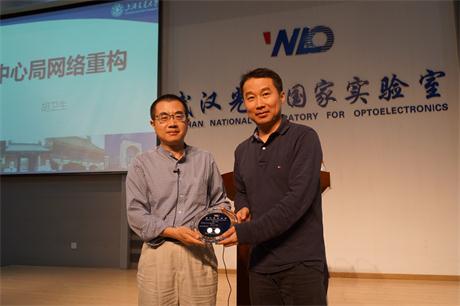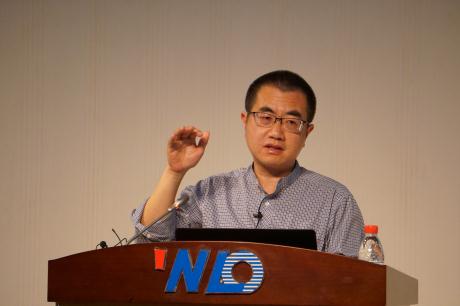WUHAN, China (May 11, 2017) - Wuhan Optoelectronics Forum No. 120 was successfully held in Auditorium A101 at Wuhan National Laboratory for Optoelectronics (WNLO) in the afternoon of May 11. Prof. Weisheng Hu from Shanghai Jiao Tong University delivered an exciting talk entitled Central Office Re-architectured Network as Datacenter. Dr. Jian Wang, from Optoelectronic Devices and Integration Division of WNLO chaired the forum. Dr. Song Xia, Chair of WNLO committee, awarded Prof. Hu the forum medal.
Just as the title implies, this presentation includes three key words: central office, network, and re-architecture. Firstly, the central office is regarded as the most important asset of operators, and is the closest buildings to the users. It accommodates a lot of network equipment, from quite earlier old to the newest ones. Traditionally, it takes a "black box" solution, and operators are so forced to bind their solutions to the venders, which causes a large variety of equipment types, high operation and maintenance costs, and hard to upgrade. Secondly, the network is really the information superhighway, and traditionally, it provides transformation of information across the world. Today, however, except for information transportation, what is most important, it also acts as repository and source of information with the emergence of data center inside the network. The traditional network is established and so fixed to some given services, and is so lack of flexibility and openness. The future network will be an all-round player, which will integrate with ubiquitous computing, software defined hardware, being readily accessible, with continuous increasing bandwidth, everything connected, and even intelligence everywhere. Therefore, it needs to introduce the third key words: re-architecture. Herewith this presentation will focuses on the Central Office Re-architectured network as Datacenter, which is called as CORD as an open project. Typically, it has three application scenarios: R (Residential)-CORD with fiber access, M (mobile)-CORD for 4G/5G, and E (Enterprise)-CORD for industry. Let’s imagine that, one day in the near future, when we return to the central office, everything is changed. All the traditional equipment have been disaggregated, and all are re-architectured as data center. This is the undergoing telecommunications transformation and will be evolved for a quite long period.
Weisheng Hu is a distinguished professor of Shanghai Jiao Tong University. He received his B.S, M.S, and Ph.D from Tsinghua University, Beijing University of Science & Technology, and Nanjing University in 1986, 1989 and 1997 respectively. He joined Shanghai Jiao Tong University as post-doctor from 1997 to 1999, and was then promoted to a full professor in 1999 and a distinguished professor in 2009. He served as expert in national projects CAINONET and 3TNET during 1999 and 2006, and deputy director and director of State Key Laboratory of Advanced Optical Communication Systems and Networks during 2002 and 2012, and the leader of Department of Electronic Engineering in 2013. He serves in several editorial boards including Optics Express, Journal of Lightwave Technology, Chinese Optics Letters and China Communications. Also he served in program committees of a number of international conference, including OFC, ICC, INFOCOM, OPTICS-East, ACP and others. He has published over 400 peer-reviewed journal/conference papers, and presented 30 invited conference papers at OFC, ECOC, CLEO/Pacific Rim. He wan some awards, such as two second prize of National Science and Technology Progress Awards, a National Natural Science Funds for Distinguished Young Scholar; and a National Key Talent Project Award. His research area covers the optical transport network, data center optical switching, and next-generation fiber access network.

